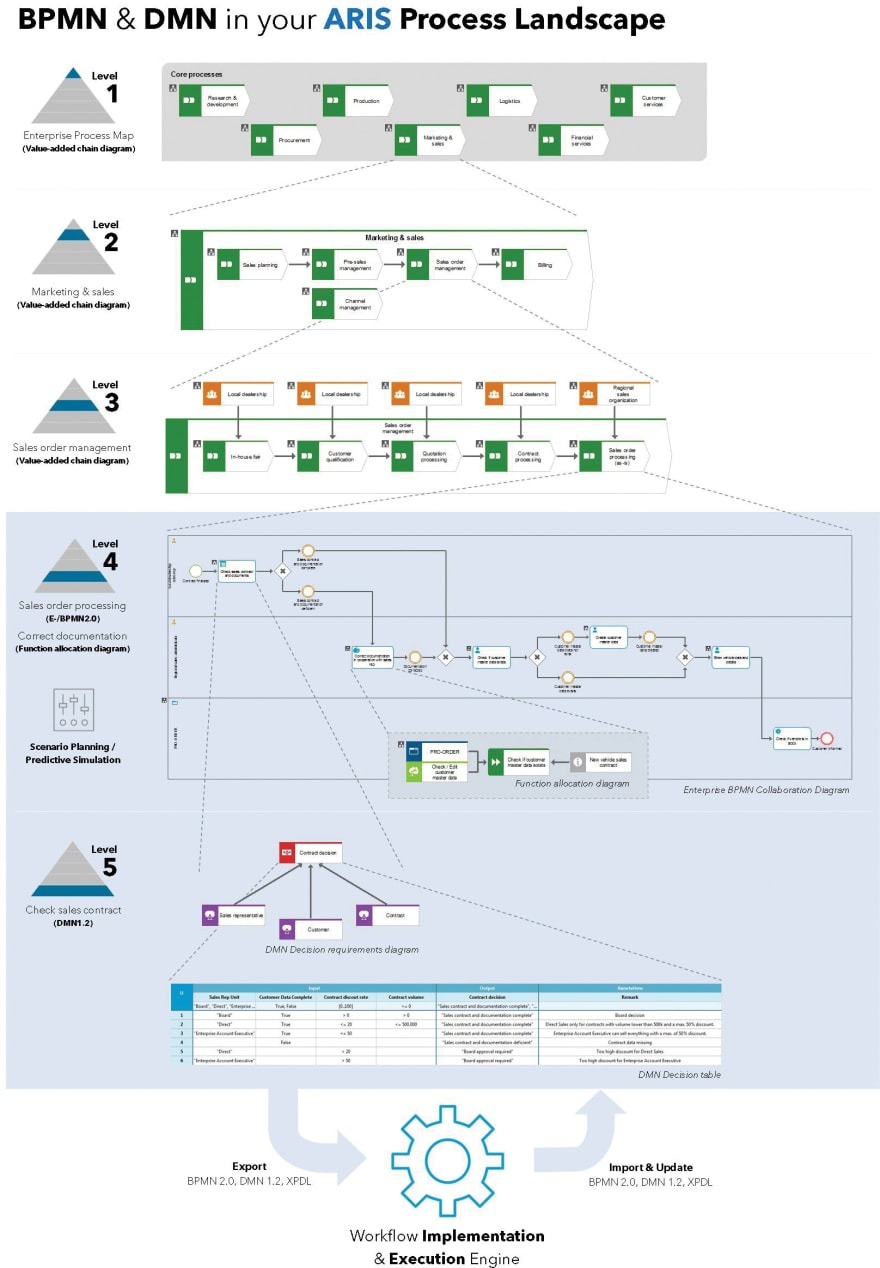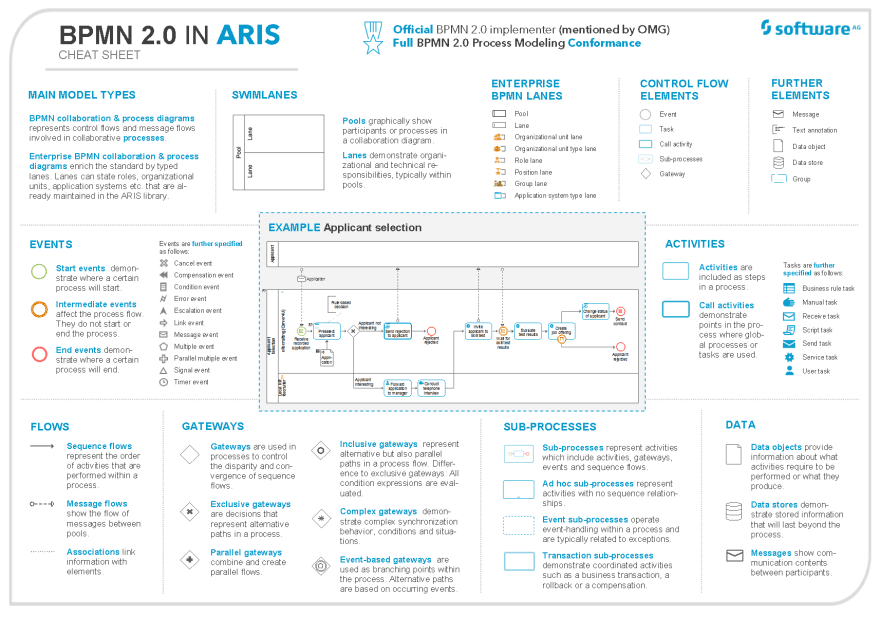Go with the leader and benefit from our unique and powerful support of the standard
Thinking about BPMN 2.0? ARIS is now an essential player. In this article you'll get deep insights on why ARIS is a BPMN 2.0 leader and how the BPMN 2.0 standard is implemented AND extended in ARIS, making it a unique and powerful combination that offers users with numerous advantages.
By Josèphe Blondaut, ARIS Product Marketing Manager, Software AG & Tom Thaler, Product Manager, ARIS, Software AG
| Issue 4, 2018 |  Download PDF Download PDF |
|---|
Overview of BPMN
BPMN stands for Business Process Modeling Notation and is a standard methodology to illustrate business processes. The Object Management Group (OMG) is now maintaining BPMN, which was developed by the Business Process Management Initiative (BPMI). BPMN was created to align business and IT with a standardized modeling language that is tool-independent and would make the exchange and the interactions between the different systems easier and safer. BPMN serves process modeling and is a standard now available in its 2.0 version.
Sponsored by the OMG, the purpose of the BPMN Model Interchange Working Group (MIWG) is to support, facilitate, and promote the interchange of BPMN Models. One important task is to reach a common agreement on interpretations of the BPMN standard to ensure better interchange. With that background, they established a test suite to validate existing tools against that agreements. The validation includes:
- Import – All models of the test suite can be imported correctly concerning visualization, object types and attributes
- Export – The designed models can be correctly exported related to file validity, object types and attributes
- Roundtripping – Imported models can be exported again (and vice versa) without any loss of information
ARIS is one of only three tools that successfully submitted all models of the three different result groups, while strong capabilities for importing, exporting and roundtripping could be proved (http://bpmn-miwg.github.io/bpmn-miwg-tools/). Finally, ARIS demonstrated a great support of that cross-vendor standard agreement.
How ARIS supports BPMN 2.0
Being a leader in process design and modeling, ARIS offers a broad set of functionalities that support BPMN 2.0 without
any disruption. ARIS is not only able to support the BPMN 2.0 standard format but extends it, too. Let’s have a detailed look:
- Modeling BPMN 2.0 – ARIS offers everything around BPMN 2.0 collaboration, process and allocation diagrams. If you want to have a detailed overview on the objects and its notation, please see our "cheat sheet" on page 4.
- ARIS offers an automatic transformation from EPC (Event- driven Process Chain – the business blueprint) to BPMN (solution blueprint). This reduces the ramp-up barriers and simplifies your first step into process automation. ARIS uses an open algorithm, which can be adapted according to individual conventions.
- Importing BPMN diagrams to ARIS and embedding them in the ARIS process landscape. This means that once a BPMN 2.0 diagram is imported into the ARIS database it can be seamlessly integrated into the existing processes via assignments and object connections. The occurrence concept is also supported and enables re-use of imported BPMN 2.0 information in other diagrams within the ARIS repository.
- Validating BPMN 2.0 diagrams thanks to the integrated ARIS semantic checks that secure the quality of process diagrams. An ARIS semantic check shows whether the model complies with the modeling conventions and detects anomalies. As a result, ARIS users will get errors, warnings or notes, directly marked on the corresponding objects in the model. ARIS provides a concrete guidance, which helps the user improve and correct the process information, making it suitable for IT.
- Updating BPMN diagrams with changes from IT. Imagine you already have process information in a specific area; this can be updated via import so that you can include relevant IT changes into the ARIS repository.
- Roundtripping with BPMN 2.0 is easy with ARIS as there is absolutely no information loss when models are transported between business and IT. This includes both individual attributes from both sides and stability of IDs, which is a key requirement for professional roundtrip scenarios. Everything within the BPMN process modeling conformance level is supported.
Why BPMN in ARIS is unique and powerful
ARIS extends BPMN by the business perspective (known from the EPC). Enterprise BPMN (E-BPMN) diagrams enable the modeler to depict business information, such as roles, organizational units and application systems, as typed lanes, within a BPMN diagram. This approach allows a seamless integration in the overall process landscape and delivers strong analysis capabilities over the complete hierarchy. In addition, it does not affect the standard or the import / export capabilities but rather extends the standard in a conformant way. With that, BPMN cannot only be used as an alternative to EPC but also as a further hierarchical level that provides all relevant information for a process automation initiative (see Figure 1).
An important aspect in such initiatives is the design of business and decision rules. As an early adopter, ARIS now supports (starting with ARIS 10 SR6) the Decision Modeling Notation (DMN™) 1.2 standard, soon to be released by the OMG. DMN does not only allow the conceptual definition of decision hierarchies and the required input data but also the logical specification of the concrete decision rules. The corresponding import and export enables an easy transfer to rule engines (mostly part of common workflow implementation and execution engines), which then automates decision making.
Finally, ARIS integrates BPMN 2.0 process information with arbitrary additional information from the ARIS repository. As mentioned in the sample hierarchy in Figure 1, Function Allocation Diagrams (FAD) are used to detail BPMN activities with, for example, risks, controls or Internet of Things objects. This states a perfect integration into a comprehensive business blueprint that considers all relevant business perspectives, such as the organizational structure, data, controls, functions and products/services.
Standard ARIS functionalities further support the BPMN 2.0 modeling and pave the way to excellence with semantic checks, reports, predictive simulation, scenario planning, SAP® synchronization and more. ARIS enables users to model BPMN quickly graphically or table-based. Relevant BPMN objects, such as lanes, events, activities and data, are simple to insert and reuse.
Templates and guided alignment make a designer's life easier and ensure that the BPMN 2.0 model is not only free of errors but also looks good and is reusable to present information. In the end, process knowledge can be communicated to end-users (viewers) in an easy way that does not require any knowledge of notations. The steps view guides them through the single process steps and provides all relevant (role-based) information side by side. Finally, runtime information derived with process mining can be consumed in the context of the model – the ARIS Root Cause Miner supports analysts in identifying bottlenecks and defects.
BPMN 2.0 in ARIS has many advantages
ARIS offers a variety of benefits when working with BPMN 2.0:
- You comply with the standard and export and import easily
- ARIS extends and enhances the standard with business information
- ARIS integrates BPMN and DMN in a comprehensive process landscape considering all relevant business perspectives
- ARIS supports you in establishing a quality gate for business process blueprinting
- ARIS is more than just BPMN 2.0 design but takes the next step based on analysis, predictive simulation, scenario planning and dash boarding
ARIS doesn't stop with BPMN 2.0 but enforces other standards. ARIS will be an early adopter of the DMN 1.2 standard and will support it from October 2018 on. This means you, as an ARIS user, will be able to combine BPMN 2.0 diagrams with DMN 1.2 decision models in ARIS. In October 2018 you can expect:
- DMN 1.2 support
- Professional DMN decision-table modeling
- DMN import/export
Trusttheleader #TrustARIS #ARIS10

Figure 1: A sample 5-level-hierarchy process landscape including BPMN and DMN in ARIS







Top comments (0)